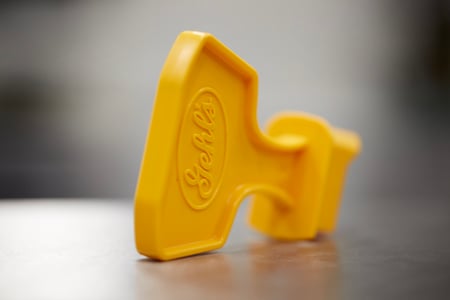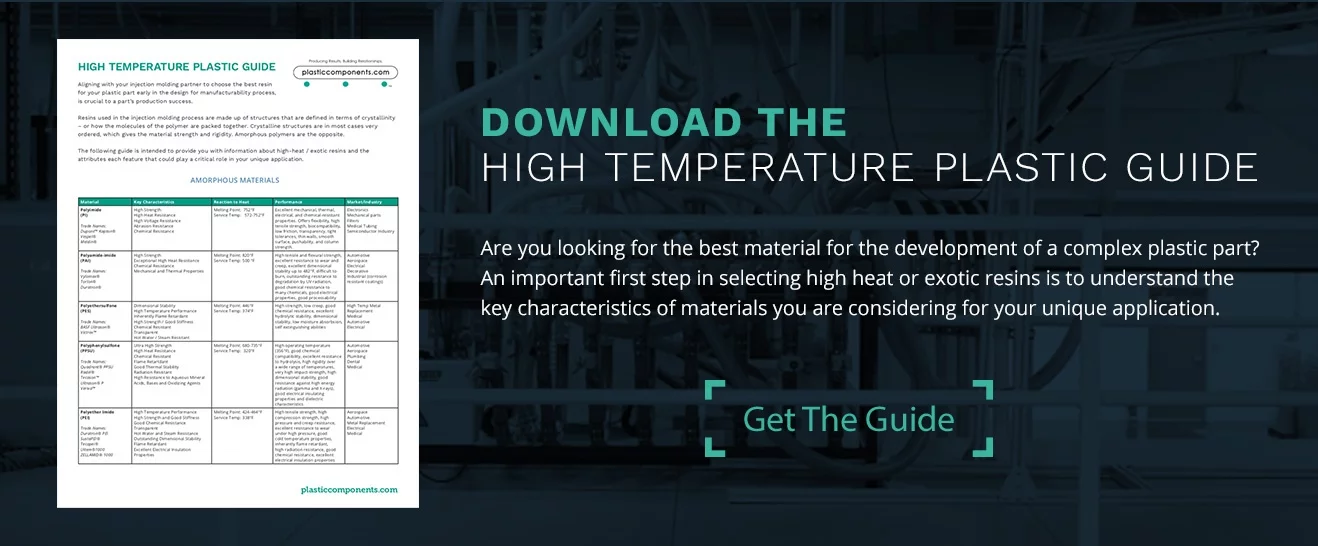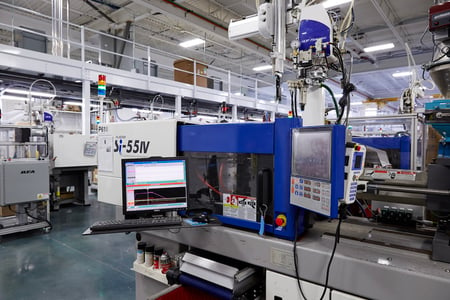Injection Mold Tool Design Molder
The Goal of Design for Manufacturing
 In the world of plastics, Design for Manufacturing (DFM) is the combination of art, science
In the world of plastics, Design for Manufacturing (DFM) is the combination of art, science
To achieve its objectives, DFM requires collaboration between the molder, OEM and customer. It must capitalize upon best in class manufacturing processes. Its principles drive a scientific molding process that includes materials selection. It needs to acknowledge and work within and up to the maximum performance capabilities of the molder's manufacturing equipment. It must utilize state of the art technology like simulation and enterprise resource planning software in the design process, and robotics and process control systems for manufacturing.
On this page, PCI explores DFM to help our customers and prospects understand its role during the design validation process, prior to tooling kick off. You can download this entire page as a PDF here, read through the entirety of our insights and observations by scrolling down this
The Basics and Benefits of Design for Manufacturing
Design for Manufacturing (DFM) involves designing a product that optimizes manufacturing efficiencies for the equipment and/or process used in its production in order to realize the lowest possible unit costs at the highest possible quality. The most important reason for integrating DFM into manufacturing a plastic injection molded product is that 70% of its manufacturing costs can be determined by design decisions.
DFM requires choosing the right manufacturing process for a part or product; investments in different technologies, using state of the art design principles (discussed below
DFM is an instrumental part of another customer demand: lowering manufacturing and assembly costs. A simple look at the way this is accomplished is presented below; however, when a DFM plan is completed deskside, it should be an engineering document laser-focused on getting a "just right" balance of quality and costs.
13 DFM Guidelines for Reducing the Costs and Challenges Associated with Manufacturing a Plastic Component
-
 Start DFM early in the design process before tooling has begun
Start DFM early in the design process before tooling has begun - Bring engineers, designers, the contract manufacturer, the mold builder, and the material supplier to the table to challenge the design
- Design to reduce the total number of parts
- Build it with a modular design
- Limit the number of machine operations needed
- Use standard components
- Design parts to be multi-functional
- Design parts for multi-use
- Design for ease of fabrication
- Avoid separate fasteners
- Minimize assembly directions
- Maximize compliance
- Minimize handling and consider how
a design impacts the packaging and shipping of parts
Source: Computer-Aided Manufacturing, Second Edition, Tien-Chien Chang, Richard A Wysk, and Hsu-Pin Wang. Pages 596 to 598. Prentice Hall 1998
Estimating Manufacturing Costs
 Source: Design for Manufacturing and Assemble, D. Havel, https://www.slideshare.net/dhaval6693/dfma-57014998
Source: Design for Manufacturing and Assemble, D. Havel, https://www.slideshare.net/dhaval6693/dfma-57014998
Why DFM is Important for the Injection Molding Process
Beyond just estimating manufacturing costs, your injection molder should be using DFM principles to reduce the costs of components, reduce the costs of assembly, reduce the costs of supporting production, and to identify the impact of DFM decisions on other factors throughout the entire design and production process.
Another reason for selecting a
Benefits of DFM for Plastic Injection Molding
- Lower Production Cost

- Higher Quality
- Quicker Time to Market
- Lower Capital Equipment Cost
- Greater Automation Potential
- Bring Production up to Speed Sooner
- Fewer Engineering Changes
- Lower materials and labor costs
- Reduce product development cycle time
- Emphasis on standards reduces costs
Critical Elements of Design Optimization
Before a mold is created, best DFM practices for plastic injection molded parts incorporate the following critical elements:
Considering Material Shrink Rate:
Shrinkage is the contraction of the molded part as it cools after injection. All materials have different shrink rates depending on resin family (amorphous vs. crystalline materials), mold design, and processing conditions.
Draft:
 How features of a part are formed in a mold determines the type of draft needed. Features formed by blind holes or pockets (such as most bosses, ribs, and posts) should taper thinner as they extend into the mold. Surfaces formed by slides may not need
How features of a part are formed in a mold determines the type of draft needed. Features formed by blind holes or pockets (such as most bosses, ribs, and posts) should taper thinner as they extend into the mold. Surfaces formed by slides may not need
- A draft angle of at least one-half degree is acceptable for most materials. High-heat and exotic resign may require one to two degrees of
draft . Add an additional degree ofdraft for every 0.001inch of texture depth. - Draft all surfaces parallel to the direction of mold separation.
- Angle walls and other part features formed in both mold halves to aid ejection and maintain uniform wall thickness.
Uniform Wall Thickness:
Uniform wall thickness throughout
If sections of different thickness are required, make the transition as smooth as possible allowing the material to flow more evenly inside the cavity. This ensures the whole mold will be fully filled and will ultimately decrease the chance for defects. Rounding or tapering thickness transitions will minimize molded-in stresses and stress concentration associated with abrupt changes in thickness.
Incorporating the proper wall thickness for your part can have drastic effects on the cost and production speed of manufacturing. The minimum wall thickness that can be used depends on the size and geometry of the part, structural requirements, and flow behavior of the resin. The wall thicknesses of an injection molded part generally range from 2mm – 4mm (0.080" – 0.160"). Thin wall injection molding can produce walls as thin as 0.5mm (0.020"). Work with an experienced injection molder and design engineer to be sure the proper wall thicknesses are executed for your part's design and material selection.
Radii to Edges:
 In addition to main areas of a part,
In addition to main areas of a part,
Ribs:
Many designers think that by making the walls of a part thicker, the strength of the part will increase. When in reality, making walls too thick can result in warpage, sinking, and other defects. The advantage of using ribs is that they increase the strength of a part without increasing the thickness of its walls. With less material required, ribs can be a cost-effective solution for added strength.For increased stiffness, increase the number of ribs rather than increasing height and space a minimum of two times the nominal wall thickness apart from one another.
Draft Angle:
How features of a part are formed in a mold determines the type of draft needed. Features formed by blind holes or pockets (such as most bosses, ribs, and posts) should taper thinner as they extend into the mold. Surfaces formed by slides may not need
Finishing:
Surface finish options for plastic injection molded parts vary depending on part design and the chemical make-up of the material used. Finishing options should be discussed early in the design process as the material chosen may have a significant impact on the type of finish implemented. In the case where a gloss finish is used, material selection may be especially important. When considering additive compounds to achieve
Consideration of these elements is fundamental for integrating engineering and manufacturing expertise to catch mistakes, see opportunities for efficiencies and cost reduction, and even assess the viability of contract requirements. Typically, your injection molder will conduct a detailed analysis of these elements with your team well before the tooling process is initiated.
DFM is not a "
PCI's Four-Part Approach to Plastic Part Design Optimization
| Design for Manufacturing | Design for Manufacturing (DFM) describes the process of designing or engineering a product to reduce its manufacturing costs, allowing potential problems to be fixed in the design phase which is the least expensive place to address them. Depending on various types of manufacturing processes there are set guidelines for DFM practices that precisely define various tolerances, rules and common manufacturing checks related to DFM. |
| Design for Functionality | Throughout the plastic part design process, it is imperative to keep |
| Design for Assembly | Design for assembly (DFA) is a process by which products are designed with ease of assembly in mind with the ultimate goal of reducing assembly time and costs. The reduction of the number of parts in an assembly s usually where the major cost benefits of DFA occurs. |
| Design for Sustainability | Design for sustainability focuses on designing parts with print measurement intent in mind - sustaining tolerances with proper measurement on an ongoing basis. |
Understanding Materials for Plastic Components and Their Role in DFM
 Material selection is a critical part of the DFM path to high quality/low cost/fast production plastic injection molded parts and products. The sheer number of types of plastics and their associated properties makes discussions between material providers, injection molders and product manufacturers critically important, as addressing specific needs early in the design process is key to avoiding costly changes later.
Material selection is a critical part of the DFM path to high quality/low cost/fast production plastic injection molded parts and products. The sheer number of types of plastics and their associated properties makes discussions between material providers, injection molders and product manufacturers critically important, as addressing specific needs early in the design process is key to avoiding costly changes later.
Materials selection affects strength and flexibility, temperature resistance, durability, appearance, toughness, life-span, and (of course) production cost. Other needs can include:
- Agency approvals
- Assembly
- Chemical resistance
- Resin availability
When it comes to selecting the right material, it takes experience, expertise
Interested in downloading this guide as a PDF? Click Here.
Discussion Points That Guide Plastics materials Selection for Injection Molding
| Chemical resistance | Child safety |
| Color | Compliance with FDA standards |
| Compliance with NSF standards | Compliance with REACH standards |
| Compliance with RoHS standards | Dielectric properties |
| Economic or cost constraints | Embossing requirements |
| Environmental conditions | Finish requirements |
| Flexibility | Food safety |
| Heat, flame or burn resistance | Material strength |
| Mechanical conditions | Need for reflectivity or transparency |
| Pressure resistance | Rigidity |
| Shelf life | Weight resistance |
A Basic Guide to Material Selection for Injection Molding
Manufacturers use a wide variety of plastics to mold parts incorporated into products and have increasingly begun to replace other materials like bronze, stainless steel, aluminum, and ceramics. Some of the most popular reasons for using or switching to plastic include longer overall lifespan of the part, reduced wear on other components of a product, faster production line speeds, corrosion resistance

Source: Grandview Research, Injection Molded Plastic Market Report by Raw Material, https://www.grandviewresearch.com/industry-analysis/injection-molded-plastics-market
Aligning with your injection molding partner to choose the best resin early in the design for manufacturability process , is crucial to a part's production success.
Material selection plays a critical role in the strength and flexibility of your molded part. Addressing specific needs early in the design process can help you avoid costly changes later. Balancing characteristics like stiffness, durability, toughness, and others are key in achieving optimal part functionality. Additionally, it's important to understand the key differences in some of the more commonly used resins.
ABS (acrylonitrile butadiene styrene) is a common injection molding material that can be sourced and molded relatively easily, at an accessible price point. It's a strong, sturdy material that offers good impact resistance, is easily machined, and meets a variety of aesthetic requirements. The resin is not ideal for parts that will be subjected to sustained intense heat as it will warp or melt above / around 200 degrees Fahrenheit.
Polycarbonates are a high-grade class of thermoplastics that are easily molded and often increases shatter resistance. Naturally transparent, polycarbonate is ideal for high-strength glass-like applications (safety goggles, medical lab applications and more). Polycarbonate isn't suited for applications where a higher degree of flexibility is needed or colored aesthetic choices.
Glass-filled nylon is a reinforced thermoplastic, where the base nylon resin has glass fibers added to it for extra strength and heat resistance. This resin is also more nonconductive to electricity than many others, but despite
Polypropylene is a flexible thermoplastic that is suitable for industrial and consumer applications. It's known as being a highly pliable resin that can be manipulated in many ways without losing its original shape. Polypropylene also offers resistance to solvents, chemicals
Acetal is known to provide great friction resistance and is a highly rigid material. It can be easily colored and dyed in the molding process; however, does not offer superior heat resistance.
One of the most vital steps when preparing for injection molding resin selection is to create a comprehensive material selection list of requirements for the product. The list should most certainly include price target and resin availability – as resin availability can be a risk and backup resin choices should be considered.
It's also important to consider that some characteristics of high heat and exotic resins are unique and may perform differently from one application to another. To realize both the design and material's fullest benefits, experienced design engineers and injection molders have a number of factors to consider.

Understanding Surface Finishing and its Role in DFM
Design for Manufacturing a plastic part or product, prior to building
In the design stage, the plastic injection molding partner, OEM
- Allowing trapped gasses to escape quickly
- Eliminating plastic flow creases
- Getting better sticker adhesion
- Improving grip
- Improving paint adhesion
- Producing a high polish finish
- Producing a smooth finish
- Producing the highest polish finish
- Removing tooling marks
- Using texture to make undercuts
Like other components of the DFM approach, surface finishing is part of the cost/quality/customer satisfaction formula that must occur at the beginning of a contract.
Material Finishes
| Finish | SPI* Standard | Finishing Method | Typical Surface Roughness Ra ( μm) |
| Super high | A-1 | Grade #3, 6000 Grit Diamond Buff | 0.012 to 0.025 |
| High | A-2 | Grade #6, 3000 Grit Diamond Buff | 0.025 to 0.05 |
| Normal glossy finish | A-3 | Grade #15, 1200 Grit Diamond Buff | 0.05 to 0.10 |
| Fine semi-glossy finish | B-1 | 600 Grit Paper | 0.05 to 0.10 |
| Medium semi-glossy finish | B-2 | 400 Grit Paper | 0.10 to 0.15 |
| Normal semi-glossy finish | B-3 | 320 Grit Paper | 0.28 to 0.32 |
| Fine matte finish | C-1 | 600 Grit Stone | 0.35 to 0.40 |
| Medium matte finish | C-2 | 400 Grit Stone | 0.45 to 0.55 |
| Normal matte finish | C-3 | 320 Grit Stone | 0.63 to 0.70 |
| Satin textured finish | D-1 | Dry Blast Glass Bead #11 | 0.80 to 1.00 |
| Dull textured finish | D-2 | Dry Blast #240 Oxide | 1.00 to 2.80 |
| Rough textured finish | D-3 | Dry Blast #24 Oxide | 3.20 to 18.0 |
| As machined | - | Finished to the machinist's discretion | 3.20 (with visible machining marks) |
Source: K. Varotsis, "Injection Molding SPI Surface Finishes", 3D Hubs https://www.3dhubs.com/knowledge-base/injection-molding-spi-surface-finishes#finishes
Other Plastic Part Finish Options Include:
- Natural\Exotic
- Micro Surface Finishes
- Multi-Gloss Patterns
- Graphics
- Leather Grains/Hides
- Woodgrain, Slate
and Cobblestone - Geometric and Linens
- Images or logos incorporated into the pattern
Technology Supporting the Plastic Injection Molding DFM Process
 In recent years, plastic injection molders have turned to the principles and technologies associated with scientific molding. The goal of scientific molding is to (1) save developmental costs and time by eliminating trial and error in the design process, (2) create dependable, defect-free tooling that eliminates costly mold rework, improves part quality, and accelerates time to market, and (3) create a repeatable and easily auditable manufacturing process.
In recent years, plastic injection molders have turned to the principles and technologies associated with scientific molding. The goal of scientific molding is to (1) save developmental costs and time by eliminating trial and error in the design process, (2) create dependable, defect-free tooling that eliminates costly mold rework, improves part quality, and accelerates time to market, and (3) create a repeatable and easily auditable manufacturing process.
The technology of scientific molding is delivered through simulation software like SOLIDWORKS® Plastics Premium software (mold flow simulation) and executed through robotics and process control systems like RJG eDart® that produces consistent,
Using and integrating technologies supporting the plastic injection molding DFM process is challenging. It involves communication and collaboration between molder, OEM and customer, across many different disciplines.
Advantages of a Scientific Molding Process
- Creates a data-driven process that produces repeatable results with little to no variation
- Facilitates smart materials selection
- Gives design engineers the ability to optimize
part design for unique applications based on past learnings and expertise - Used to optimize tool design or to optimize poorly designed
- Recorded data used to assess quality control and make any necessary tweaks to improve overall part quality
Injection Mold Tool Design Molder
Source: https://www.plasticcomponents.com/design-for-manufacturing-in-plastic-injection-molding-guide
Posted by: kistlercaude1987.blogspot.com

0 Response to "Injection Mold Tool Design Molder"
Post a Comment